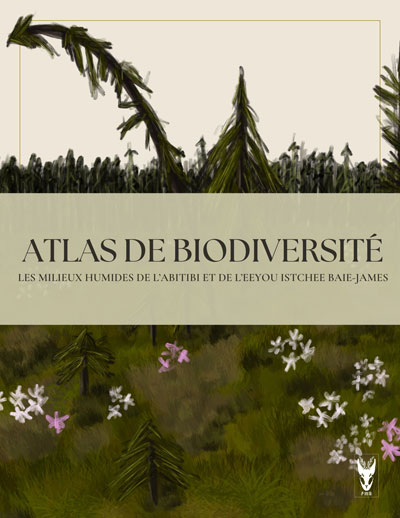
Angélique Dupuch
Chercheur régulier
Écologie Animale
Université du Québec en Outaouais
Institut des Sciences de la Forêt Tempérée
58 Rue Principale
Ripon (Québec) J0V 1V0
Tél.:(819) 595-3900 poste 2938
FORMATION
- 2008: Doctorat Sciences de l'Environnement (Université du Québec à Trois-Rivières)
- 2000: Équivalent à la maîtrise, DEA en Écologie et Biologie de l'Évolution (Université de Montpellier II)(Languedoc)
- 1998: Maîtrise Biologie des Populations, option milieu marin (Université de Bretagne Occidentale à Brest)
- 1997: Équivalent au baccalauréat, Licence en Biologie des Organismes (Université de Bordeaux I)
THÈMES DE RECHERCHE
Mes intérêts de recherche se concentrent sur la compréhension des facteurs environnementaux et écologiques déterminant les patrons spatiaux d’abondance des populations animales et l’assemblage des espèces dans des paysages perturbés. Les principaux thèmes de recherche que j’aborde sont la sélection de l’habitat, les interactions trophiques et la compétition intra- et interspécifique, et les réponses de la faune aux perturbations naturelles et anthropiques du paysage. Pour la réalisation de mes projets, j’utilise une approche combinant études théoriques et expérimentales, en laboratoire et en milieu naturel. Le but ultime de mes travaux est d’aider à la conservation des populations et de la diversité animales via la compréhension des processus qui déterminent leur dynamique spatio-temporelle.
J'ai été membre du Comité Consultatif en Matière d’Aménagement (CCMA) de la Commission Régionale sur les Ressources Naturelles et le Territoire Public de l’Outaouais (CRRNTO – 2013-2014). Je suis membre du Centre de la science de la biodiversité du Québec (CSBQ) ![]()
PUBLICATIONS
Livres
Aucun
Chapitres de livre
Aucun
Livres, numéros spéciaux et actes de colloques publiés à titre d'éditeur
Aucun
Articles révisés par un comité de lecture
- Aubin, I., Deschenes, E., Santala, K.R., Emilson, E.J., Schoonmaker, A.L., McIntosh, A.C., Bourgeois, B., Cardou, F., Dupuch, A., Handa, I.T. et al. (2024) Restoring forest ecosystem services through trait-based ecology. Environmental Reviews, 32(4):498-524
- Bonnell, T.R., Michaud, R., Dupuch, A., Lesage, V., Chion, C. (2024) Estimating spatial mixing within the St. Lawrence Estuary beluga population by comparing local individual diversity and abundance. Marine Mammal Science, 40(4):e13162
- Mazaleyrat, A., Le Borgne, H., Lorenzetti, F., Dupuch, A. (2023) Do disturbance-induced habitat changes drive alien species invasion success and native species decline? A case study based on slug species inhabiting managed deciduous forests. Biological Invasions, 25(7):2343 – 2359
- Postaire, B., Dupuch, A., Ladent, E., Surget-Groba, Y. (2023) Vernal Pool Amphibian Inventories in the Temperate Forests of Eastern North America: Can Environmental DNA Replace the Traditional Methods? Forests, 14(10)
- Mazaleyrat, A., Lorenzetti, F., Dupuch, A. (2022) Invasion of alien slugs in disturbed habitats: role of behavioural phenotype, plasticity and interspecific competition. Animal Behaviour, 183:29-40
- Mazaleyrat, A., Lorenzetti, F., Aubin, I.e, Venier, L.A., Hébert, C., Fortin, D., Dupuch, A. (2022) Towards a better understanding of the effect of anthropogenic habitat disturbance on the invasion success of non-native species: slugs in eastern Canadian forests. Biological Invasions, 24(5):1267 – 1281
- Bonnell, T.R., Michaud, R., Dupuch, A., Lesage, V., Chion, C. (2022) Extracting spatial networks from capture–recapture data reveals individual site fidelity patterns within a marine mammal’s spatial range. Ecology and Evolution, 12(2)
- Bellerose, J., Dupuch, A., Aubin, I. (2022) Changes in Understory Composition of Rural North American Temperate Forests after a 14-Year Period with Focus on Exotic and Sensitive Plant Species. Forests, 13(5)
- Rainville, V., Dupuch, A., Pepino, M., Magnan, P. (2022) Intraspecific competition and temperature drive habitat-based resource polymorphism in brook charr, Salvelinus fontinalis. Evolutionary Ecology, 36:967-986
- Rosner, S., Dupuch, A., Lorenzetti, F. (2022) Stuck between the Mandibles of an Insect and of a Rodent: Where Does the Fate of Ash-Dominated Riparian Temperate Forests Lie? Forests, 13
- Schmidt, N.M., van Beest, F.M., Dupuch, A., Hansen, L.H., Desforges, J.-P., Morris, D.W. (2021) Long-term patterns in winter habitat selection, breeding and predation in a density-fluctuating, high Arctic lemming population. Oecologia, 195(4):927-935
- Chion, C., Bonnell, T.R., Lagrois, D., Michaud, R., Lesage, V., Dupuch, A., McQuinn, I.H., Turgeon, S. (2021) Agent-based modelling reveals a disproportionate exposure of females and calves to a local increase in shipping and associated noise in an endangered beluga population. Marine Pollution Bulletin, 173
- Tauc, F., Houle, D., Dupuch, A., Doyon, F., Maheu, A. (2020) Microtopographic refugia against drought in temperate forests: Lower water availability but more extensive fine root system in mounds than in pits. Forest Ecology and Management, 476
- Buchkowski, R.W., Morris, D.W., Halliday, W.D., Dupuch, A., Morrissette-Boileau, C., Boudreau, S. (2020) Warmer temperatures promote shrub radial growth but not cover in the central Canadian Arctic. Arctic, Antarctic, and Alpine Research, 52(1):582-595
- Morris, D.W., Dupuch, A., Moses, M., Busniuk, K., Otterman, H. (2019) Differences in behavior help to explain lemming coexistence. Journal of Mammalogy, 100(4):1211-1220
- Chion, C., Bonnell, T.R., Lagrois, D., Michaud, R., Dupuch, A. (2019) Reducing the impacts of shipping on the st. Lawrence estuary beluga population: Modelling and prediction of whale exposure to vessel noise under prospective scenarios. The Journal of Ocean Technology, 14(3):138-139
- Le Borgne, H., Dupuch, A., Fortin, D. (2018) Ecological processes determining the distribution dynamics of vole populations during forest succession. Oecologia, 188(3):721-732
- Le Borgne, H., Hébert, C., Dupuch, A., Bichet, O., Pinaud, D., Fortin, D. (2018) Temporal dynamics in animal community assembly during post-logging succession in boreal forest. PLOS ONE, 13(9)
- Bichet, O., Dupuch, A., Hebert, C., Le Borgne, H., Fortin, D. (2016) Maintaining animal assemblages through single-species management: The case of threatened caribou in boreal forest. Ecological Applications, 26(2):612-623
- Allard-Duchene, A., Pothier, D., Dupuch, A., Fortin, D. (2014) Temporal changes in habitat use by snowshoe hares and red squirrels during post-fire and post-logging forest succession. Forest Ecology and Management, 313:17-25
- Dupuch, A., Morris, D.W., Ale, S.B., Wilson, D.J., Moore, D.E. (2014) Landscapes of fear or competition? Predation did not alter habitat choice by Arctic rodents. Oecologia, 174(2):403-412
- Dupuch, A., Morris, D.W., Halliday, W.D. (2014) Patch use and vigilance by sympatric lemmings in predator and competitor-driven landscapes of fear. Behavioral Ecology and Sociobiology, 68:299-308
- Dupuch, A., Bertolo, A., Magnan, P., Dill, L.M. (2014) Indirect effects of asymmetrical competition among top predators determine spatial patterns of predation risk for prey. Aquatic Sciences, 76:543-552
- Dupuch, A., Fortin, D. (2013) The extent of edge effects increases during post-harvesting forest succession. Biological Conservation, 162:9 - 16
- Morris, D.W., Dupuch, A. (2012) Habitat change and the scale of habitat selection: Shifting gradients used by coexisting Arctic rodents. Oikos, 121(6):975-984
- Morris, D.W., Dupuch, A., Halliday, W.D. (2012) Climate-induced habitat selection predicts future evolutionary strategies of lemmings. Evolutionary Ecology Research, 14(6):689-705
- Paradis, Y., Dupuch, A., Magnan, P. (2012) Comparison of catch efficiencies between black and galvanized minnow traps. North American Journal of Fisheries Management, 32(3):539-543
- Morris, D.W., Moore, D.E., Ale, S.B., Dupuch, A. (2011) Forecasting ecological and evolutionary strategies to global change: An example from habitat selection by lemmings. Global Change Biology, 17(3):1266-1276
- Ale, S.B., Morris, D.W., Dupuch, A., Moore, D.E. (2011) Habitat selection and the scale of ghostly coexistence among arctic rodents. Oikos, 120(8):1191-1200
- Dupuch, A., Paradis, Y., Magnan, P. (2011) Behavioural responses of prey fishes to habitat complexity and predation risk induce bias in minnow trap catches. Journal of Fish Biology, 79(2):533-538
- Dupuch, A., Dill, L.M., Magnan, P. (2009) Testing the effects of resource distribution and inherent habitat riskiness on simultaneous habitat selection by predators and prey. Animal Behaviour, 78(3):705-713
- Dupuch, A., Magnan, P., Bertolo, A., Dill, L.M., Proulx, M. (2009) Does predation risk influence habitat use by northern redbelly dace Phoxinus eos at different spatial scales? Journal of Fish Biology, 74(7):1371-1382
- Dupuch, A., Magnan, P., Dill, L.M. (2004) Sensitivity of northern redbelly dace, Phoxinus e eos, to chemical alarm cues. Canadian Journal of Zoology, 82(3):407-415
Articles publiés dans des actes de colloque (proceedings)
Aucun
Rapports scientifiques, manuels et autres
- Morris, D.W., Dupuch, A. (2013) Arctic lemmings: keystone species in a changing environment. Science Report 2012-2013, Polar Continental Shelf Program
- Reid, D., Bilodeau, F., Dupuch, A., Ehrich, D., Gauthier, G., Gilbert, S., Kenney, A.J., Krebs, C.J., Morris, D.W., Schmidt, N.M. et al. (2011) Dans ArcticWOLVES: Arctic Wildlife Observatories Linking Vulnerable EcoSystems. Rapport de synthèse final Chapter 3: Small mammals, Centre d'études nordiques, Université Laval
Thèses, mémoires et essais
- Dupuch, A. (2008) Comportement dynamique de prédateurs et de proies dans un système à plusieurs habitats. Thèse de doctorat, Université du Québec à Trois-Rivières
Thèses, mémoires et essais supervisés
- Rosner, S. (2023) Importance des frênes pour la biodiversité dans les forêts ripariennes sous influence du castor (Castor canadensis) et de l’agrile du frêne (Agrilus planipennis). Thèse de doctorat, Université du Québec en Outaouais
- Mazaleyrat, A. (2021) Mécanismes associés au succès d'envahissement d'espèces exotiques animales dans les habitats perturbés : étude du complexe de limaces Arion subfuscus s.l. dans des habitats perturbés par des coupes forestières. Thèse de doctorat, Université du Québec en Outaouais
- Côté-Bourgoin, S. (2019) La simplification structurelle de la végétation dans les plantations de peuplier hybride mène à des différences de communautés d'oiseaux avec les forêts naturelles. Mémoire de maîtrise, Université du Québec en Outaouais
Articles non révisés par un comité de lecture
Aucun
<< Jérôme Dupras | MembresReguliers | Patrick Faubert >>










